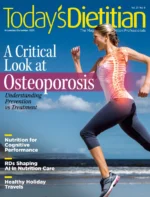Today’s Dietitian
Vol. 26 No. 1 P. 46
The holidays are a time for traveling and reconnecting with loved ones over food and fun, and this may cause many clients to step away from their normal healthful eating routines. In response to this, the new year brings with it new goals and resolutions often centered around physical activity, healthful eating, and weight loss.
However, no matter how ambitious clients are feeling on New Year’s Day, these resolutions often fall by the wayside if clients aren’t intentional about setting goals that are realistic, sustainable, and compatible with their lifestyles.
In fact, a report from the fitness tracking app Strava estimates that despite their best intentions, users are most likely to give up on their fitness resolutions by January 19th.1
This article will discuss the latest research on the roles of intrinsic vs extrinsic motivation in behavior change and provide strategies for guiding clients through the process of setting realistic and sustainable fitness goals that will last well beyond January.
Extrinsic vs Intrinsic Motivation
The key to guiding clients in establishing sustainable fitness interventions is understanding the two crucial types of motivation for activity: extrinsic motivation and intrinsic motivation. Extrinsic motivation is behavior driven by external outcomes. Individuals who are extrinsically motivated in their fitness routines may be driven by a specific outcome such as calories burned, weight management, or social approval.2 On the other hand, intrinsic motivation is behavior driven by internal feelings associated with that behavior. Individuals who are intrinsically motivated in their fitness regimens may be driven by feelings of enjoyment, excitement, and personal accomplishment.2
Research shows that while extrinsic motivation is a critical factor in adopting a new exercise behavior, intrinsic motivation is important for long-term exercise participation.2 Therefore, encouraging clients to base fitness resolutions around activities they find inherently satisfying will support a more sustainable increase in physical activity, which in turn promotes cardiovascular, metabolic, and musculoskeletal health.3 From a mental health standpoint, exercise is associated with lower stress and higher life satisfaction, but only when intrinsic motivation is present.4 This highlights the importance of guiding clients toward enjoyable forms of movement to support both physical and mental health.
Find the Joy in Movement
While signing up for a gym membership or a 5K event are common goals for many individuals setting New Year’s resolutions and may be great options for some, many people won’t be intrinsically motivated to do these types of activities. However, there’s still a wide variety of other types of movement to consider. Asking clients if there are any activities or sports that they’ve enjoyed in the past is a great starting point for setting fitness goals. From there, it may be helpful to address underlying incongruities between the types of activities clients think they “should” be doing vs the activities they enjoy doing. While clients may perceive certain activities as being a better workout, choosing whichever form of movement they’re most likely to participate in consistently will ultimately have the greatest impact on their physical and mental health.
Some clients may thrive on the routine of participating in a single type of physical activity, while others may prefer to engage in a variety of activities. The latter will enable them to take advantage of more varied health benefits that come with different forms of movement, such as improvements to bone health from weight-bearing exercise, increased muscle mass from strength training, enhanced flexibility from yoga and Pilates, and cardiovascular fitness from aerobic or high-intensity workouts. Below are a variety of physical activities clients can consider:
• walking, hiking, or running;
• tennis or pickle ball;
• swimming;
• water aerobics;
• dance classes;
• yoga, Pilates, or barre;
• indoor or outdoor cycling;
• adult sports leagues;
• skateboarding or rollerblading;
• rock climbing;
• high-intensity interval training classes;
• individual or group strength training; and
• home workouts using apps such as YouTube, Nike Training Club, Peloton, SWEAT, and Centr.
Setting Realistic, Sustainable Fitness Goals
In addition to choosing enjoyable forms of movement, the following tips can help RDs guide clients through the process of setting realistic and sustainable fitness goals.
Be Specific
To help clients set fitness resolutions that will last, encourage them to be as specific as possible when creating their goals and action plans. For example, instead of setting a general goal to do more yoga, help them set a goal to complete a specific number of classes per week and talk through the logistics of fitting yoga into their schedules. Some clients may benefit from the structure of setting weekly reminders to sign up for workout classes or adding time for home workouts into their schedules. Others may benefit from keeping shelf-stable preworkout snacks and any necessary gear ready to go in their car so they can easily head straight to a gym, studio, or hiking trail on the way home from work or other errands. Mapping out these specific details with clients as part of their action plan will help them avoid common barriers to meeting fitness goals.
Avoid the All-or-Nothing Mentality
Dietitians have all seen clients start the year with lofty fitness goals, then burn out. Starting a fitness journey with an overly ambitious goal can lead to feelings of overwhelm and failure, which can cause clients to give up. In addition, clients with an all-or-nothing mentality may overlook the importance of rest days for injury prevention. Advise clients to start with a small goal and expand on it over time while incorporating rest days at least once per week. This helps set clients up for success and reduces the risk of injury that can come with starting a new activity. RDs should assuage clients’ concerns about a smaller fitness goal by assuring them that even relatively small increases in physical activity are associated with significant health benefits.3 The focus should remain on a gradual, realistic, and sustainable fitness regimen.
Avoid Focusing on Weight Loss
While weight loss goals are commonly expressed by clients as motivators for increased physical activity, focusing on a client’s weight status can reinforce weight stigma—or the negative beliefs and ideologies that are based on an individual’s body size. Weight stigma is associated with exercise avoidance and decreased exercise enjoyment, as well as broader negative effects on physical and psychological well-being.5 For clients with a strong extrinsic motivation for weight loss, shifting the focus to how exercise makes them feel and discussing the benefits for overall health and wellness may help increase intrinsic motivation and reduce weight-based shame, resulting in a more sustainable behavioral change. A systematic review found interventions that encourage enjoyable movement and weight inclusivity were associated with increased physical activity levels.6
Find a Workout Buddy
Finding a friend or group with which to work toward fitness goals may increase the likelihood of success. A 2019 Strava report found that distance was 21% longer in workouts completed with others.1 Furthermore, working out with a friend may increase the enjoyment of the activity, thus enhancing intrinsic motivation and helping clients build community around their preferred activity. Playing backyard sports with family or joining adult sports leagues are additional ways to combine interpersonal connection and joy with physical activity.
Final Thoughts
With so many forms of movement to choose from, making fitness resolutions and setting goals shouldn’t feel like a grind. By uncovering motivations for exercise, engaging in collaborative goal setting, and providing support along the way, RDs can help clients prevent feelings of failure often associated with fitness resolutions and instead help them feel empowered and accomplished.
— Kate Evans, MS, RDN, is a clinical dietitian at the UCLA Vatche & Tamar Manoukian Division of Digestive Diseases and a consultant dietitian at Kelly Jones Nutrition, a performance nutrition private practice that supports athletes at every level.
References
1. Haq S. This is the day you’re most likely to let your New Year fitness goals slip. Runner’s World website. https://www.runnersworld.com/uk/training/a776013/today-is-the-day-youre-most-likely-to-let-your-new-year-fitness-goals-slip/. Published January 8, 2020. Accessed September 24, 2023.
2. Teixeira PJ, Carraça EV, Markland D, Silva MN, Ryan RM. Exercise, physical activity, and self-determination theory: a systematic review. Int J Behav Nutr Phys Act. 2012;9(1):78.
3. Warburton DER, Bredin SSD. Health benefits of physical activity: a systematic review of current systematic reviews. Curr Opin Cardiol. 2017;32(5):541-556.
4. Meyer S, Grob A, Gerber M. No fun, no gain: the stress-buffering effect of physical activity on life satisfaction depends on adolescents’ intrinsic motivation. Psychol Sport Exerc. 2021;56:102004.
5. Bevan N, O’Brien KS, Lin CY, et al. The relationship between weight stigma, physical appearance concerns, and enjoyment and tendency to avoid physical activity and sport. Int J Environ Res Public Health. 2021;18(19):9957.
6. Dimitrov Ulian M, Pinto AJ, de Morais Sato P, et al. Effects of a new intervention based on the Health at Every Size approach for the management of obesity: the “Health and Wellness in Obesity” study. PLoS One. 2018;13(7):e0198401.



